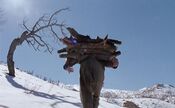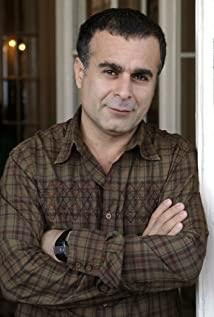"What's your name?"
"Amina."
"How old are you?"
"I'm younger than Maddy."
"Who is Maddy?"
"My dwarf brother, he's sick. That's the one in the yellow coat. That. We took him to the doctor today, to the hospital."
"What does your dad do?"
"He smuggles, mules to Iraq, and brings other shipments back."
"Do you have a mother?"
"No, she died when she gave birth to my sister. Now Luzhen is our mother."
"Who is Luzhen?"
"My sister."
"Is Luzhen here?"
"No, she takes care of my sister at home. That It's Ayong, my brother."
"How many children do you have?"
"Three sisters, two brothers."
One minute and fifteen seconds. Very concise and wonderful.
The interview dialogue in the form of a big and a small question and answer on a black screen not only very clearly summarizes Amina's complex family background, but also cleverly uses a period of time when subtitles are usually boring to arouse the audience's interest and quickly pull the audience. into the movie.
The shooting method is cold and objective, without any lyricism or even background music. The lens is basically parallel to the characters, whether it is a child or a deformed Maddie, no matter how small, all use the same height lens, showing an objective vision. For the performance of the relationship between the children, the middle and close shots are on the upper side, and many times, in the cold Iran, when the mules used for smuggling have to drink to warm up, for the children next to the dead branches in the snow scene, the author has The long shot is chosen, and the dead branches are often used as a close scene. The white snow is shocking, and the children are so small and so important in the center of the lens slightly farther away.
The characteristic of the narration is that the voice-over narrator is the younger sister Amina, but the protagonist of the film is indeed the strong boy Ayong.
There are no dazzling long takes, no tense cuts, everything is like life, smooth and cold.
The camera is like a silent eye of God, silently leading the audience to watch all this. It even gave many people the illusion that it was a documentary. We, the only child born in New China who grew up under the red flag, never seem to have imagined that there are children living like this in the world. When they were 12 years old, they were about to become the male masters of the family, abandoning their identities as children and smuggling to support their families at the risk of being killed by landmines.
These children are all adults. In order to save her younger brother Ma Di from marrying, the elder sister only changed a mule; Ma Di, as a disabled person, watched his family pay for himself, and watched him be ridiculed and despised but could not react; the eldest son Ayong protected the family and dropped out of school to support the family; Amina also takes on the burden of taking care of the family. Among these children, it seems that only the little girl with little ink has the innocence of a child. She is lying in her sister's arms with a broken doll. I don't know that this is what my brothers and sisters sacrificed their childhood in exchange.
No one will forget the scene where Ayong and Amina were left by the escaped children in the snow, and they were holding Ma Di and feeding medicine in the snow. Amina kept kissing Maddie to keep his icy hands warm. No matter how bad the environment is, the younger brothers and sisters will not abandon this poor little dwarf. Every time I hear them "tweet" kissing his face, my heart "pulls".
Luzhen married an Iraqi man in order to cure Madi. A teenage teenage girl sacrificed her life just like that. But the mother-in-law was not willing to accept Ma Di. In the end, her sister's life was only exchanged for a mule for this poor family.
Finally, when the drunk mule was scared into the snow and couldn't get up, I finally understood what the title meant.
The adults in Iran unloaded their tires and ran for their lives. In this world where no one has credibility and no one is a child, no one takes a look at Ayong. Ayong slapped the mule hard, "Get up, get up quickly." The mule was bought by her sister's happiness, and it was the guarantee of Ma Di's life. How could Ayong be willing to leave it behind?
In the final shot, Ayong leads a mule across the border between Iran and Iraq.
We don't know if they got the mule, got the money to operate on the poor little dwarf who was crying, or was killed by a landmine on the way.
The future of the child, like the future of peace, has infinite hope, but its life and death are uncertain.
When they crossed the barbed wire of the border, like giants, they carried the burden of life and crossed the misery.
View more about Zamani barayé masti asbha reviews







